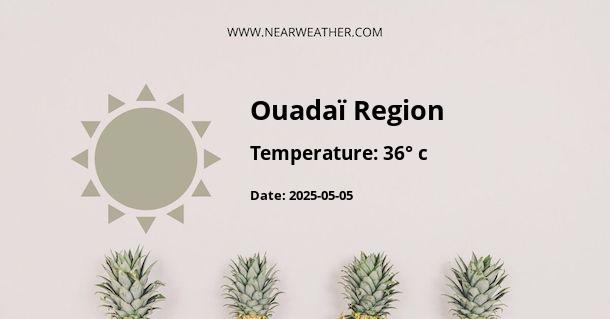Introduction
The Ouaddaï region, located in the eastern part of Chad, is a region known for its unique weather patterns and climatic conditions. Home to the Ouaddaï highlands and the city of Abéché, the region's climate is majorly influenced by its geographical positioning and topography. The region experiences a tropical savanna climate with a wet and dry season.
Ouaddaï's Climate Classification
The Köppen-Geiger system classifies Ouaddaï's climate as 'Aw', which stands for a tropical savanna climate with a pronounced dry season in the low-sun winter season. The average annual temperature in Ouaddaï is around 27.3 °C, with annual rainfall averaging at approximately 788 mm.
| Climate Variable | Value |
|---|---|
| Average Annual Temperature | 27.3°C |
| Average Annual Rainfall | 788 mm |
Temperature
The region experiences moderately high temperatures throughout the year, with the hottest month being April (average temperature: 31.7°C) and the coldest month is December (average temperature: 23.4°C).
Rainfall
Ouaddaï's rainfall pattern is typically tropical, with a dry and a wet season. The dry season usually runs from November to April and the wet season from May to October. July is the most precipitous month with an average rainfall of about 173 mm.
Humidity and Wind
Humidity levels in Ouaddaï vary inversely with temperature, being highest during the cooler months and lowest during the warmer months. Wind patterns in the region are largely influenced by the Harmattan wind. This dry and dusty trade wind blows from the Sahara Desert over West Africa into the Gulf of Guinea and affects the region's weather conditions, particularly during the dry season.
"The Harmattan wind plays a significant role in shaping the weather patterns of Ouaddaï, leading to cooler temperatures and lower humidity levels in the region during the dry season."
Overall Climate Impact
The climate of Ouaddaï has a profound impact on the region's flora and fauna. The wet season supports the growth of savanna grasslands and sparse woodlands, which offer sustenance to a variety of wildlife species. Meanwhile, the dry season, characterized by sparse rainfall and the Harmattan wind, leads to drier conditions, affecting agricultural practices and water availability.
Conclusion
In conclusion, the Ouaddaï region of Chad experiences a tropical savanna climate characterized by a dry and wet season. Its weather patterns are influenced by various factors, including its geographical position, the Harmattan wind, and the region's topography. A deeper understanding of these conditions is vital for effective planning and management of the region's resources and biodiversity.
A - Ouadaï Region's Latitude is 13.500000 & Longitude is 21.250000.
A - Weather in Ouadaï Region is 30° today.
A - Climate Conditions in Ouadaï Region shows overcast clouds today.
A - Humidity in Ouadaï Region is 10% today.
A - Wind speed in Ouadaï Region is 32.98 km/h, flowing at 73° wind direction. today.
